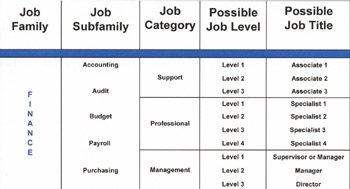SISC making progress on new job structure
![]()
| 23 April 2003
| |  This is an example of how campus jobs in the field of finance might fit into the new classification structure proposed by SISC. A similar scheme would be applied to other job families on campus, such as student services, human resources, general administration, skilled crafts and trades, and information technology, among others. The SISC committee will spend the next several months refining the various sections of this proposed structure to ensure thorough coverage and descriptions of all staff positions at Berkeley. |
The Staff Infrastructure Steering Committee — as part of its ongoing efforts to revamp the campus’s 50-year-old job-classification and compensation system — recently unveiled a proposed structure that organizes the work people do at Berkeley within a new series of job families, subfamilies, categories, and levels.
“The way it is now, there are folks on campus with the same title who do different work,” says committee member and Haas School of Business lecturer Cris Banks, “as well those who do the same work but have different titles.”
The proposed new structure would eliminate these discrepancies between positions by defining and categorizing jobs based on the nature of the work performed, she adds, making the classification of jobs more accurate and consistent across campus.
A job family describes broad types of work performed within the same general occupation, such as finance, student services, or information technology. Beneath that are subfamilies, which identify more-specific areas within a job family. For example, subfamilies within the finance job family would include accounting, auditing, budget, payroll, and purchasing.
Next are categories, which provide a broad definition of the nature of work performed by staff. The new structure has four categories: support, professional, manager, and vocational/trades and crafts. Within each category will be a set of numeric levels that group positions based on comparable factors, such as responsibility, scope, and impact.
“In the proposed structure, the support and manager categories have three levels, and the professional category has four,” says Banks. “We want enough levels so that distinct differences between responsibilities are captured, but not so many that the distinctions get lost.”
These levels will not correspond to the numeric assignments used in current job titles, she adds. For example, someone who is now classified as a Student Affairs Officer III might be a Student Affairs Specialist 2 under the new structure.
No demotions, no pay reductions
“This would not represent a demotion of any sort,” Banks emphasizes. “There are fewer levels in the new structure, so there won’t be a direct match to what we currently have. Moreover, the chancellor has promised that no one’s pay will be reduced as a result of this restructuring.”
Banks says the committee realizes that some jobs cross over two or more job families, like a department manager who performs human-resources, budget, and administrative work for a particular department. In these instances, the work the person spends the most time doing will determine the job family. If it is an equal split among various duties, then the job would probably fall into the general administration job family.
Next steps for the committee include further refinement of the job families, subfamilies, and level descriptors. Later this year, individual staff and their managers will be asked to provide specific job-content information, and to recommend where each person’s job should fit in the new structure. Subject-matter experts will review this information and adjust recommended matchings where needed, to ensure consistency across campus. Staff and their managers will have an opportunity to review these final matchings and can appeal any decision that seems inappropriate. SISC will roll out the new structure after the matching process is complete and the campus has reviewed all implications of the new system. Committee members estimate this will happen in 2004.
“This is an enormously large and complex project, and we want to make sure it gets done right the first time,” says Banks. “But to accomplish that goal will take time.”
Other new programs in the works
The proposed job structure will serve as the foundation for new performance-management and career-development programs, which SISC is also working on. It will also make it easier to compare campus jobs and salaries with those in the marketplace. Though no university funds are available for major salary adjustments at this time (due to the state budget crisis), positions that are identified as grossly under market and difficult to recruit will receive top priority when UC finances improve, says Banks.
The committee encourages feedback from staff on the new structure. E-mail sisc@uclink.berkeley.edu with comments and questions. Visit sisc.berkeley.edu for information about the Staff Infrastructure Steering Committee.

